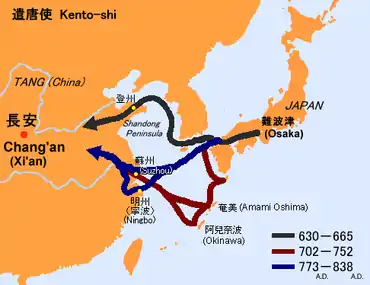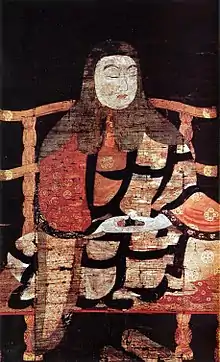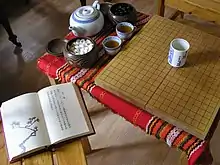Chinese influence on Japanese culture
Chinese influence on Japanese culture refers to the impact of continental Asian influences transmitted through or originating in China on Japanese institutions, culture, language and society. Japanese pop culture has become famous internationally through anime and manga, but older elements of its culture such as Taoism, Buddhism, astronomy and language have been profoundly influenced by China over the course of centuries.
History
Conflicts caused by Chinese expansion in the later stages of the Jōmon Period, circa 400 BCE, led to mass migration to Japan.[1] The migrants primarily came from continental Asia, more specifically the Korean Peninsula and Southern China, which brought over "new pottery, bronze, iron and improved metalworking techniques", which help improve the pre-existing farming tools and weaponry.[1][2] Chinese influence came mostly by sea, but also through Korea.

The influence of Chinese culture was an indirect effect of communications by Korea, around the 1st to the 5th century A.D.. Korea had already incorporated major elements of Chinese civilization into their own culture, and from there, mediated the interchanges between China and Japan.[3]
The Han Shu written in 82 A.D. (also known as 'the book of Han' or 'History of Han') states that the Wa sent envoys and tribute to the Jùn (Chinese commandery) in northern parts of Korea.[1] To further expand, the Wa was a confederation of minor southern and western states of Japan, with an emphasis on the state Yamato. According to the Han Shu, this was the first textual reference made to Japan, in reference to Sino-Japanese interaction. Another Chinese source that documents Chinese influence on Japanese culture is Wei Chih written in 297 A.D. (also known as History of Wei). Wei Chih states that Chinese and Japanese interactions of tribute originates back to 57 and 107 A.D. Prominent figures of authority, such as Queen Himiko, sent Japanese ambassadors to parts which belonged to the Chinese, around 189–248 A.D.[1] This continued in the Kofun Period, as envoys continued to be transmitted from Japan into China. In 502 A.D., eleven new envoys were sent to China. This was, according to Mark Cartwright, the emergence of Yamato Japan as an international diplomatic state.[1]
In comparison to Korea, Japan controlled its intake of cultural influence from China, also known as 'cultural borrowing'. This meant that it "acknowledged the cultural superiority of the Chinese Middle Kingdom", while always holding onto its political independence.[3] In addition to controlling the process of 'cultural borrowing', Japan also remained selective when considering which Chinese ideas and institutions they wanted to adopt.
Influence on religion
Daoism/Taoism

Daoism/Taoism is a set of religious and philosophical beliefs which explores the ideas of rituals, scriptures all whilst considering the Dao/Tao. It can be traced back to the 3rd century BCE.[4] As a product of Chinese philosophers, it made its way to Japan and has thus been significantly changed as it became in contact with the Japanese Culture. Originally, as Daoism developed in China was complex, multifaceted and a continuous recreation of new and old ideas.[5] Its form as it became integrated into Japanese culture was introduced as a part of the ritsuryō state. As a result of this, through textual pieces, Daoism marketed its way gradually into Japanese Culture, though different from its original influence, which was Chinese Daoism.
Debates regarding Daoism/Taoism
There have been debates regarding which undefined elements of Daoism within "the Japanese religio-political landscape" belongs to history and traditions of China, and which are merely an aspect of Daoism itself.[5] Author and research associate Gaynor Sekimori, argues that aspects such as cosmology, yin and yang, Wu Xing (the five phases), divination, astronomy/astrology and the Yijīng were originally a part of Chinese cultural heritage, which thus influenced Daoism.
There has also been a level of uncertainty regarding Daoism/Taoism, whether it be majoritively Chinese culture or simply influenced a part of Daoism. Jonathan Smith made claims as to distinguish what is a part of Chinese heritage and that of Daoism itself, claiming there are elements which are "Daoist" and "Taoist-flavoured".
Building on this, Japanese philosopher Miura Kunio distinguishes specific elements of Daoism as either belonging to the Chinese culture or as aspects transferred into the Japanese culture following the introduction of Daoism.[5] To further expand, Kunio claimed that elements that were presented to Japan in the seventh century, such as "calendar-making, astronomy/astrology and divination" as belonging to the Chinese Culture. Elements such as immortality beliefs, Daoist scriptures and Kōshin cult were transferred into Japan as a part of Daoism.
Buddhism
Now one of the largest world religions, Buddhism first emerged from India around 6th century BC. Buddhism has three major 'branches', which include Theravada (foundational Buddhism), Mahayana (or 'Greater Vehicle' Buddhism) and Vajrayana (Esoteric Buddhism or 'Diamond Vehicle'). Buddhism was brought over to Japan through China and Korea in the year 552.[6]
Furthermore, Buddhism was encouraged by those in power, such as Prince Shotoku. He argued that Buddhism was essential in "promoting Chinese ideas". Out of the three branches of Buddhism, it was the Mahayana which first became rooted in the Japanese culture.
Introduction of Vajrayana Buddhism and establishment of Mahayana sects

Another example of Chinese influence on Japanese religion is the introduction of Vajrayana Buddhism. In the beginning of the Heian Period, several Japanese monks that had studied religion in China returned, consequently establishing Vajrayana Buddhism through the creation of Buddhist sects.[7] Specifically, two scholar monks known as Saichō and Kūkai helped create the Tendai sect and Shingon sect. The Tendai sect was created in 805 by Saichō following his return from T'Ang China, and helped firmly establish Vajrayana.
To further expand on this, Saichō travelled to China for eleven months in 804 on the quest for the T'ien- t'ai (or Tiantai), the Chinese Buddhist School.[7] Saichō wanted to transfer the idea of the T'ien- t'ai Dharma heritage into Japan, while still keeping the authenticity of the original Chinese-based Buddhist school. In his final month in Ming-chou, Saichō went to Yüeh-chou in order to gather further religious texts concerning esoteric Buddhism (Vajrayana); where he essentially meet the priest Shun-hsiao who informed him and gave him instructions about Vajrayana Buddhism. Following his visit to Yüeh-chou, Saichō was able to retrieve Buddhist instruments, related to rituals, paintings of the goddesses of Vajrayana and 38 religious texts related to Mikkyō. In accordance to several pieces historical research "both inside and outside the Tendai school demonstrates that Saichō encounter with Mikkyō in China was rather accidental".[7] Furthermore, according to Japanese historian Kōyū Sonoda, Saichō's original plan consisted of sending two disciples to do his research on the T'ien-t'ai, though it was changed last minute as Emperor Kanmu was able to persuade Saichō to pursue and lead the journey personally.
From there, Saichō helped 'pave the way' for the Shingon sect to be introduced in 806 by Kūkai. In order for both founders to benefit from the introduction of Buddhism, Saichō stood behind Kūkai and helped him get the mountain temple of Takaosan-ji northwest of Kyoto, and make it into the original Shingon School. In return, Kūkai helped educate and train Saichō and his followers Vajrayana rituals. Furthermore, Kūkai also shared his Mikkyō texts which he had gotten during his final trip to Yüeh-chou, China.
Influence of Chinese astronomy
Professor at Doshisha University, Kazuhiko Miyajima argues that Japan was heavily influenced by Chinese astronomy and astrology.[8] The Japanese learnt about Chinese astronomy first from the Koreans, who consequently learned it directly from the Chinese. The influence of astronomy took roots in government offices, as a direct influence of the Chinese model, which became known as "Onmyo no tsukasa". This office was in charge of specific information related to both astronomy and astrology, identical to the elements distinguished to be a part of Daoism. The four departments a part of the office includes "divination by celestial omens, calendar-making time-keeping and yin-yan divination".[8] The responsibility of these departments is similar to the Chinese equivalent T'ai shih chu and T'ai-pu shu.
In terms of cardinal direction, orientation in main streets in cities such as Naniwa no miya and Heijo Kyo was achieved by "learning the Chinese way of surveying".[8]
In addition, Japanese star maps were influenced by Chinese astronomy, as several star maps within Japan held the same Chinese star names. They were created as a direct duplication of the Chinese, though only a few still remain popular. To further elaborate, Shibukawa Harumi, known as the "first official astronomer of the Edo period", published two kinds of star maps, adapted from the traditional Chinese model which came from Korea.[8] Some star maps which were created by Takahashi Kageyasu and Ishizaka Joken continue to take inspiration from Western ideals of Astronomy. Western astronomy essentially landed in Japan through China, through a book known as "T'ienching huomen". The book's popularity in China was short-lived due to its simplification, excessive mistakes and inaccuracy, but succeeded immensely nonetheless in Japan.
Language
Kanji: Usage of Chinese characters in Japan
Kanji is the term for the adopted Chinese characters used in the Japanese written language. The Chinese writing system influenced the spoken Japanese language first, and thus "provided key vehicles for intellectual creativity".[3] Its origin in Japan dates back to the Kofun Period, and its introduction is believed to be between the years 300 and 710 A.D.[9]
It is believed that the Japanese writing system came under influence by the Chinese through its written language. In the beginning, writing in Japan was primarily done by immigrant clerks who wrote in Chinese.[10] One individual in particular known as Wani helped introduce the Chinese characters into Japan. Wani was a scholar that had arrived sometime during the late 4th century from one of the Korean kingdoms Paekche (also known as Baekje).[9] He supposedly brought 11 volumes of Chinese writings with him to Japan. Wani remained in Japan, and helped inspire groups of scribes that later became known as the Fumi-no-obito. Literacy was rare and limited to immigrant groups and their families during the 5th and 6th century. The act of writing and learning Chinese was instigated in Japan in the early 5th century.
Within the 7th century, Japanese scholars-aristocrats began to learn Chinese through reading and writing, with the purpose of doing business.[10]
The adaption of the Chinese characters was said to be challenging, but its outcome allowed Yamato Japan to establish bureaucracy. It also helped Japanese authority figures to gain control of clans and peasants. Moreover, the introduction of Chinese into the Japanese language broadened the Japanese access to educational texts on ranging subjects, such as science, religion, art and philosophy. Consequently, as Japanese students began to master Chinese they were able to travel to China and thus continue to learn about the language and culture.[3]
It has been said that the introduction of Chinese characters and learning in the 4th century A.D. highlighted a grand "turning point in Japanese cultural development".[3]
Government
Nakatomi no Kamatari created the clan known as Fujiwara in the year 645. It was successfully in power right up until the 11th century, where the military class (or the Samurai) assumed its position. Following the Fujiwara clan, the Taika reforms were created in 646. The Taika reforms helped create a new government system influenced by the Chinese model.[11] What this entailed was that land was purchased by the state and thus redistributed fairly to all. This land reform was gateway for "introducing the new tax system that was also adopted from China".
Gallery
Many cultural items are part of Sino-Japanese heritage: here are a few examples:
References
- "Ancient Japanese & Chinese Relations". Ancient History Encyclopedia. Retrieved 2018-11-08.
- "Yayoi linked to Yangtze area". www.trussel.com. Retrieved 2019-04-27.
- Stearns, Peter N. (2000). The Spread Of Chinese Civilization To Japan. Pearson. p. 394.
- Liu, King Shu (1917). "The Origin of Taoism". The Monist. 27 (3): 376–389. doi:10.5840/monist191727311. JSTOR 27900647.
- Sekimori, Gaynor (2018). "Daoism in Japan: Chinese Traditions and Their Influence on Japanese Religious Culture Ed. by Jeffrey L. Richey". The Journal of Japanese Studies. 44: 181–186. doi:10.1353/jjs.2018.0018. S2CID 148685937 – via JSTOR.
- Hammer, Elizabeth. "Buddhism in Japan". Asia Society.
- Abé, Ryūichi (1995). "Saichō and Kūkai: A Conflict of Interpretations". Japanese Journal of Religious Studies. 22 (1/2): 103–137. doi:10.18874/jjrs.22.1-2.1995.103-137. JSTOR 30233539.
- Miyajima, Kazuhiko (1988). "Influence of Chinese Astronomy on Japanese Culture". Vistas in Astronomy. 31 (1): 805–808. Bibcode:1988VA.....31..805M. doi:10.1016/0083-6656(88)90310-8.
- "Birth of the Chinese script and its adoption in Japan". Heritage of Japan. 2009-01-29. Retrieved 2018-11-08.
- Grigg, Hugh (30 June 2013). "Hanzi and Kanji: Differences in the Chinese and Japanese Character Sets Today". East Asia Student.
- Irving, Richard (25 March 2014). "Taika Reforms". Nakasendo Way.

